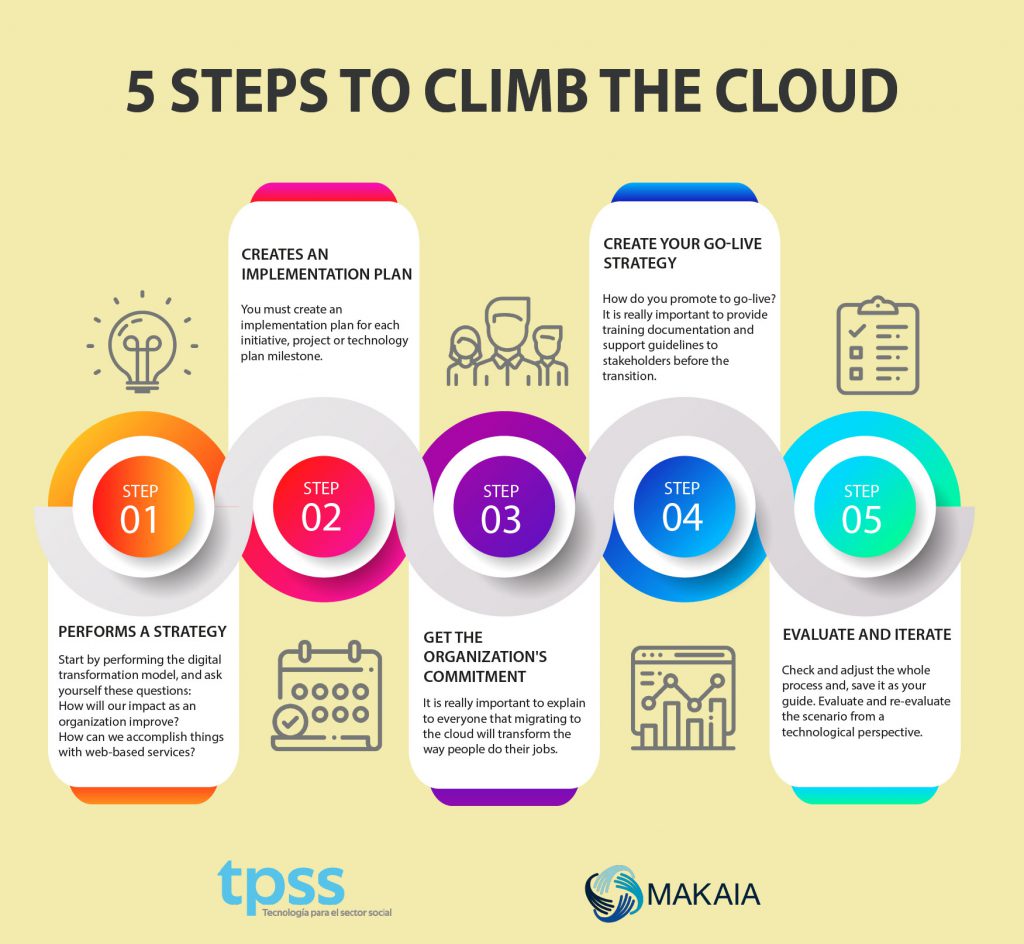With this infographic, you will understand how your non-profit organization can develop and implement a strategy in the cloud. We will explain the key steps to make this process a success in your organization and not a headache.
Step 1: Make a strategy
The purpose of a digital transformation strategy is to provide decision makers with a diagnosis and projections of the estimated impact of the technological implementation. For this we recommend that you complete the free MAKAIA Self-Diagnosis to measure your level of digital transformation and prioritize your goals.
Here are some questions to ask yourself:
• What are our objectives?
• How will the cloud improve the organization’s security, performance, and availability of technology services?
• How will you reduce costs?
• How will you improve our impact as an organization?
• ¿Cómo podemos lograr estas cosas con servicios basados en la web?
Step 2: Create an implementation plan
Once you have considered your digital transformation strategy, the next step is to think about how to create an implementation plan. You’ll need to create a series of key implementation activities for each initiative, project, or milestone in your digital transformation plan. Prioritize transition efforts based on outcome, cost, and risk assessments. For example, where is the most critical or at-risk data?
Step 3: Get the organizational commitment
The next step is to get acceptance from your organization. The solutions we develop seek for organizations to be successful, we want them to be adopted and get the maximum benefit from those solutions. The best way to do this is to gain user acceptance first and then organization. MAKAIA has provided implementation services for social organizations that want to upload to the cloud and has accompanied the user acceptance process, we invite you to meet them here.
It is really important to explain to everyone that migration to the cloud will transform the way people do their work in your non-profit organization. You must show people how to make each project help them do their job better, faster, easier, and more safely.
Step 4: Create your Go-Live strategy (start using the tool)
Consider and plan the transition process to get the tool up and running. It can be a transition by stages and short milestones or it can be done in parallel, the previous tool is no longer used and the new one is implemented
Also consider that your organization should always have some kind of contingency plan. It could be as easy as making sure the systems you had before are still working, and you can go back to them if necessary. Sometimes when migrating from one system to another, there is data involved, and you may not want to move all the data at the same time.
Step 5: Evaluate and iterate
The last step is evaluation and iteration. You can use the plan, do, check, adjust the cycle as your guide. Organizations must evaluate and reevaluate the landscape from a technological perspective.
Technology is changing more and more rapidly. 15 or 20 years ago, organizations invested in a monolithic solution that offered many services as a package, or paid for add-ons or modules within that great system. Now, licenses like Microsoft 365 will allow you to have several solutions at the same time, easy to implement for non-technical people and also have 24/7 technical support with the Microsoft customer service team.



